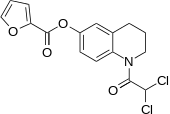Quinfamide
Quinfamide is a drug that has anti-parasitic properties.[1]
 | |
| Clinical data | |
|---|---|
| Routes of administration | Oral |
| ATC code |
|
| Identifiers | |
| |
| CAS Number | |
| PubChem CID | |
| ChemSpider | |
| UNII | |
| CompTox Dashboard (EPA) | |
| ECHA InfoCard | 100.057.690 |
| Chemical and physical data | |
| Formula | C16H13Cl2NO4 |
| Molar mass | 354.18 g·mol−1 |
| 3D model (JSmol) | |
| |
| |
| | |
Synthesis
Quinfamide is one of a relatively small family of antiamoebic compounds containing a dichloroacetamide function.
The synthesis begins by amidation of 6-hydroxytetrahydroquinoline with dichloroacetyl chloride. The sequence is completed by acylation with 2-furoyl chloride.
References
- Davila-Gutierrez CE, Vasquez C, Trujillo-Hernandez B, Huerta M (March 2002). "Nitazoxanide compared with quinfamide and mebendazole in the treatment of helminthic infections and intestinal protozoa in children". The American Journal of Tropical Medicine and Hygiene. 66 (3): 251–4. doi:10.4269/ajtmh.2002.66.251. PMID 12139216.
- US 3997542, Bailey DM, assigned to Sterling
- Bailey DM, Mount EM, Siggins J, Carlson JA, Yarinsky A, Slighter RG (May 1979). "1-(Dichloroacetyl)-1,2,3,4-tetrahydro-6-quinolinol esters. New potent antiamebic agents". Journal of Medicinal Chemistry. 22 (5): 599–601. doi:10.1021/jm00191a031. PMID 458814.
This article is issued from Wikipedia. The text is licensed under Creative Commons - Attribution - Sharealike. Additional terms may apply for the media files.
